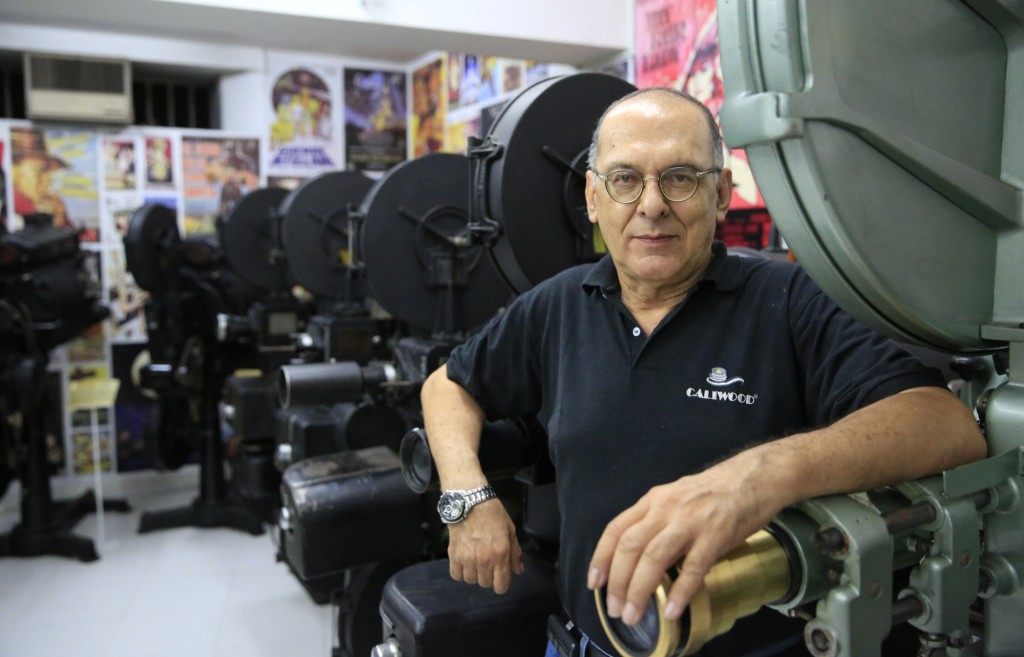
A curious visitor at the Caliwood museum in Colombia. (Photo: Frederick Bernas)
 When Hugo Suarez Fiat arrived at the workshop where he was repairing a classic car one Saturday morning in 2003, an unexpected discovery awaited him.
When Hugo Suarez Fiat arrived at the workshop where he was repairing a classic car one Saturday morning in 2003, an unexpected discovery awaited him.
Mr Suarez, a lawyer by trade and a mechanic by hobby, planned to inspect the paint job of a Ford Custom Convertible that he was restoring to its former glory.
But instead he found two huge 1930s cinema projectors rescued from a nearby theatre, which was set to close down.
The projectors had been left at Mr Suarez’s workshop in the hope they would land in the right hands.
They obviously did. “I saw those projectors, and I fell in love with them,” recalls Mr Suarez.
Some 13 years later, he has amassed over 100 more – and that is just part of his collection at Caliwood, as he has called the first cinematography museum in Colombia.
Located in the eastern town of Cali, the museum boasts more than 600 exhibits, from posters to a mini cinema that screens films using antique projectors.

The Caliwood entrance hall. (Photo: Frederick Bernas)
It opened in 2008. As well as archiving analogue technology, the museum pays tribute to a golden generation of local filmmakers whose ideas defined Colombian cinema in the 1970s.
One of them was Andres Caicedo, a maverick director who committed suicide at age 25 and whose Yashica Super 600 camera is one of Caliwood’s most treasured possessions.
Another of Mr Suarez’s favourites is a Multilith Cameragraph 1450, built in the US in 1928. Billed by the owner as “the world’s largest camera”, it looks almost comically enlarged – even by vintage standards – and sits on an iron slider used to adjust focal length.
Mr Suarez found it hidden above a recycling centre.
He is constantly following “clues” to new items and recently acquired an Omega watch used by the 007 character in Bond films such as Goldeneye and The World Is Not Enough.

Hugo Suarez Fiat presides over his collection. (Photo: Frederick Bernas)
Perhaps the most mysterious piece is a Cali Magic Lantern, named after the city even though its true origin remains unknown.
“We know it’s a chimney lamp that was used to illuminate celluloid plates and project them on screen,” explains Mr Suarez. “But we’ve not even been able to identify the country or company that made it.”

The Cali Magic Lantern. (Photo: Caliwood Museum)
He contacted museums in Spain and the US, with no luck, but vows to continue his quest for answers. The 67-year-old is a former commercial attorney who has clearly lost none of his appetite for closing cases.
Mr Suarez is ably assisted by Santiago Cardenas, a projectionist with three decades of experience who shares the founder’s obsession for all things cinema.
They met completely by chance, before the museum existed.
Mr Suarez’s two original projectors were on display in the window of his downtown office; Mr Cardenas could not resist taking a closer look as he passed by.
“The projector is where the magic begins,” he says. “In cinemas, people always look back at where that primordial light is coming from.”
As a child, Mr Cardenas made deliveries for his father’s pharmacy.
When a hung-over projectionist called for emergency headache pills on the job, young Santiago felt that magic for the first time.
“I was nine years old, desperate to try… and he let me light the projector’s lamp!” Mr Cardenas remembers, his eyes lit up in excitement.
Years later, his projecting career was halted by the birth of a daughter. After dabbling in business ventures, Mr Cardenas spent 10 years training as a Catholic deacon, before leaving the church and returning to his original creed.

Santiago Cardenas operates one of his beloved projectors. (Photo: Frederick Bernas)
“What I do now is another kind of vocation,” says the 57-year-old, who joined Caliwood’s full-time staff in 2012.
“Being a projectionist is a trade, not a profession,” he continues. “You’re the last link with the dream factory that is a film. It’s a huge responsibility, because you’re in charge of bringing people into that cinematic universe.”
At the museum, Mr Cardenas has meticulously restored dozens of projectors and films on 8mm or 16mm reels.
Famous characters include King Kong, Charlie Chaplin, Donald Duck and Zorro; the programme changes every week.
“This place is like a little time machine,” he says. “It becomes a channel between kids and their grandparents, and helps people remember their childhoods. It’s a window to the past.”

The collection includes projectors by Kodak, Bell&Howell, Ansco, Yashica and others. (Photo: Frederick Bernas)
And the Caliwood collection will surely continue to grow. Mr Suarez believes it could reach four times its current size with greater financial resources.
“The museum makes you feel like it will never end. There are no limits,” he says. “But just imagine… if those two projectors hadn’t been left beside my car, all those years ago, we probably wouldn’t even be here!”
Published @ BBC.com, 28/5/16 – click here for original.

